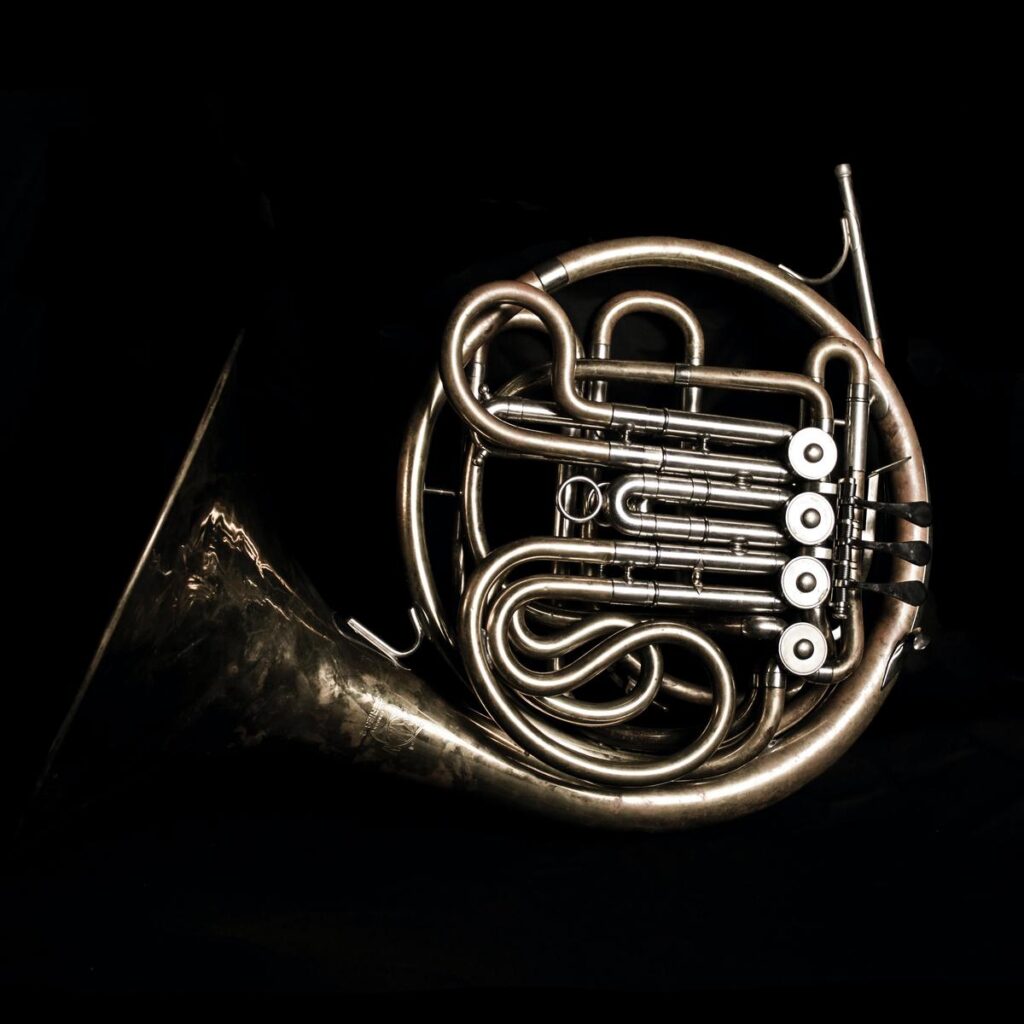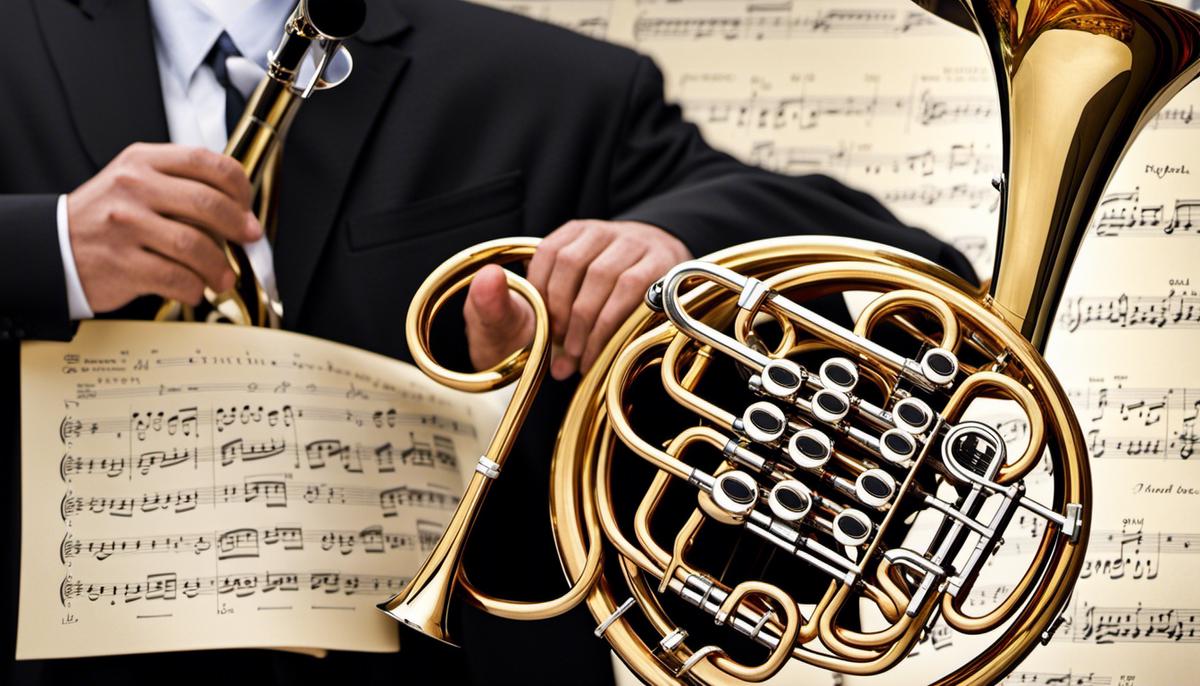Table of Contents
Introduction
In the diverse realm of music, the French horn holds a unique position, touted for its rich, majestic sound that can evoke a wide range of emotions. Mirroring its complex sound, the technique involved in playing the French horn is equally multifaceted, requiring an understanding of its mechanics and careful mastery of several skills. This begins with grasping the fundamental elements of the French horn, such as its history, anatomy, playing posture, and basic care.
As important is the need to understand and learn how to read and interpret French horn music represented in musical sheets and notations. Embouchure, often considered as the heart of wind instrument playing, is another aspect that a budding French horn player must foster.
Developing a proper embouchure pattern, involving precise control of facial muscles and positioning of lips, is vital in producing different pitches and tones. Challenges related to embouchure, commonly faced by beginners, can indeed be overcome with proper guidance and persistent practice.
Understanding the Basics of the French Horn
History of the French Horn
The French horn, often simply referred to as the horn, has a vast history beginning in the 1700s. Originating in France, it was initially used as a hunting horn before being incorporated into orchestral music. Over the centuries, the instrument has evolved in both its shape and construction, undergoing major design changes in the 19th and 20th century. An understanding of this historical journey is crucial to acknowledging the instrument’s evolution and present form.
Understanding the Parts of the French Horn
The construction of the French horn encompasses many parts, each playing a crucial role in the instrument’s overall function. Key components include the mouthpiece, where the player’s breath initiates the sound; the leadpipe which connects the mouthpiece to the body; and the tuning slides which adjust the pitch by changing the tubing length. The instrument’s main body comprises the large flaring bell, which projects the sound; the main tubing and the valves. The valves modify the airflow and thereby the pitch of the notes produced.
Proper Holding and Posture
Properly holding the French horn involves a comfortable seated position, with your feet flat on the floor for stability. The instrument should be held with the left hand on the valves and the right hand placed lightly inside the bell. Be sure your fingers are curved and relaxed, and avoid clenching the instrument too tightly. Maintaining good posture is essential to reducing the strain on your back and shoulders and allowing free deep breathing.
Care and Maintenance of the French Horn
Routine maintenance helps protect the French horn and ensure it functions correctly. Regularly oil the valves, clean the mouthpiece, and occasionally flush the entire instrument with warm soapy water, followed by thorough drying to prevent water spots and potential rusting. Handle the French horn by the leadpipe rather than the mouthpiece to avoid damaging the areas where the instrument is most delicate. Always store the horn in its case when not in use to protect it from dust, moisture, and potential damage.
Reading Musical Notations for the French Horn
Reading sheet music for the French horn primarily involves understanding the treble clef notation. Essential elements include notes, rests, sharps, flats, key signatures, and time signatures. Musical notes exist in different durations—from whole notes to sixteenth notes—and correspond to specific pitches on the horn. Rests indicate durations of silence. Sharps and flats modify notes by half a step, while the key signature, indicated at the beginning of the staff, determines the scale in which the music is played. The time signature, also placed at the start, determines the meter or rhythmic structure.
Learning the Basic Techniques for the French Horn
When learning to play the French horn, there are some fundamental techniques to grasp. These include effective finger positioning, detailed articulation like slurs and staccato, and implementing dynamics. Finger positioning requires the left hand to key press, adjusting the pipe length, which changes the pitch in the process. Articulation, on the other hand, pertains to the style of play for the notes, whether they are fluid and linked (legato), sharply distinct (staccato), or have minor changes in attack and shift. Dynamics deal with volume management, with notation as ‘pp’ for extremely soft, ‘ff’ for extremely loud, and a range of in-between levels. Perfecting these basics prepares the foundation for further French horn techniques study.

Embracing French Horn Embouchure
Grasping Embouchure in French Horn Playing
Embouchure is a term that relates to the way a wind instrumentalist positions and moves their lips, tongue, and facial muscles to generate sounds from their instrument. For French horn players, the unique rounded, conical mouthpiece structure requires the musician to establish a different lip formation compared to other brass instruments. The formation is more of an “ooh” shape rather than the “ee” shape that, for instance, trumpeters use.
Essential Role of Facial Muscles and Lip Position in Playing French Horn
Playing the French horn demands a well-coordinated interaction between various groups of facial muscles and accurate lip positions. The facial muscles maintain the firmness of your cheeks and the necessary spaces in your mouth while the lip muscles control the tension and aperture, important for affecting pitch, tone, and volume. Lower pitches, for instance, require more relaxed lips, whereas higher pitches need tighter lip tension.
Importance of Proper Breath Control
Breath control functions as the fuel for any wind instrument and each note requires a specific amount of breath to resonate properly. In terms of the French horn, players need to understand that how you inhale, the use of your diaphragm, and the way you exhale, are all crucial. Taking in a deep breath by expanding your diaphragm rather than with shallow chest breathing can make a significant difference to your sound. Moreover, consistent and controlled exhaling enables a steadier flow of air, which influences the stability of your notes.
Addressing the Common Embouchure Problems Among Beginners
Beginners often encounter a variety of embouchure obstacles from straining the muscles around the lips to improper breath control. These can result in a weak or wobbly tone, lack of accurate pitch control, or a limited range. To overcome them, it is advised to adopt regular practice habits, working on various exercises which build muscle strength and endurance. Long tone exercises can be beneficial to develop endurance and control, while lip slurs can help hone flexibility and coordination.
Incorporating Tonguing Techniques
Alongside the lip positioning and breath control, tonguing techniques also contribute significantly to the sound quality and articulation of the French horn. For optimal sound projection, the tongue acts like a valve, regulating the airflow and adding percussive elements for varied musical expressions. Various techniques, like single, double, and triple tonguing, offer different articulations and can greatly enhance your overall performance.
The Influence of Different Mouthpiece Sizes
The size of the mouthpiece can significantly influence embouchure, as different sizes accommodate different lip sizes and shapes. A larger mouthpiece can offer a richer and deeper tone and can be easier to control, but may require more lip strength and stamina. Conversely, a smaller mouthpiece may be more agile and easier to hit higher notes with, but might lack some depth to the sound in the lower register. An appropriate fitting mouthpiece is, therefore, critical to developing a strong and healthy embouchure.
Consistent Practice to Improve French Horn Techniques
Constant and mindful practice is the fundamental key to mastering the French horn. It’s about understanding the instrument’s nature, learning essential playing techniques, and persistently performing exercises to improve. By having an expert opinion from qualified teachers or experienced players, beginners can be guided to develop great embouchure habits from the onset.
The fundamentals of embouchure are pivotal in applying French horn techniques, enabling musicians to coax harmonious and stirring notes from this intricate yet rewarding instrument.

Techniques of French Horn Articulation
Mastering Articulation on the French Horn
Articulation on the French horn relates to the application and control of initiating, sustaining, and modulating notes. The act of articulation leaves a profound impact on the overall sound generated from the French horn as it polishes the tone, regulates speed, and facilitates versatility in playing diverse musical styles. To deliver precise and moving performances, mastering the art of articulation – consisting of techniques like legato, staccato, slurring, and tonguing – is of utmost importance.
Legato Articulation Technique
The legato articulation technique, meaning ‘tied together’ in Italian, is a style of playing that maintains each note as long as possible before transitioning to the next one, without any perceivable gap. This produces a smooth, flowing musical line. Practicing legato technique on the French horn often involves long-tone and lip slur exercises. The aim is to focus on the flow of air, ensuring it doesn’t stop as you change from note to note. Control is key when playing in legato, as you want to avoid any abrupt or unintended sharpness in tone when transitioning between notes.
Staccato Articulation Technique
The staccato articulation technique for French horn denotes a style where notes are played shorter and separated from each other. The term means ‘detached’ in Italian. This technique involves quick, clear tonguing and immediate cessation of sound after the note is produced. To practice staccato articulation, one effective exercise is to play a scale or passage in a staccato style, focusing on creating clear, distinct notes.
Slurring Technique in French Horn Articulation
Slurring in French horn articulation refers to a technique where multiple notes are played in a single breath, without the tongue producing a clear beginning to each note. The sound is smooth and connected, somewhat similar to legato, but slurring involves playing more than one note during a single tonguing action. Practicing slurring on the French horn generally requires mastering lip control to adjust pitches without using the tongue to separate notes.
Tonguing Technique for French Horn Articulation
Tonguing is the technique used to separate notes using the tongue’s action on the reed or mouthpiece. In French horn articulation, tonguing is the primary method for starting notes. Different tonguing techniques, like single, double, and triple tonguing, give unique effects. Proper tonguing technique requires consistent practice, focusing on precision and cleanliness of sound. A common exercise for tonguing improvements involves playing scales while concentrating on clean, crisp note beginnings.
Honing Your French Horn Articulation Skills
Whether you’re a beginner or more experienced player, strengthening your French horn articulation takes deliberate, focused practice. Different tactics can improve your skillset. Take legato articulation – begin by practicing phrases using only your lips and breath control, gradually introducing a gentle tongue action to distinguish each note. For staccato, concentrate on the accuracy and crispness of your note execution.
Practicing articulation patterns – like scales and etudes – also aids in developing these techniques. By switching between different styles like legato, staccato, slurring and various tonguing methods, you’ll better grasp how your tongue, lips, and airflow each contribute to the French horn’s unique articulations. Coupled with regular review of basic techniques, continual practice will lead to remarkable improvements in articulation proficiency.
French Horn Fingering Techniques
Navigating the Intricacies of French Horn Fingering Techniques
Becoming adept at playing the French horn requires a thorough understanding of fingering techniques. This involves learning how to utilize different finger placements on the instrument’s keys to generate various pitches and notes. The complexity of French horn fingering is, in part, due to its double horn design that most players employ. This design includes a primary F horn and a supplemental B-flat horn, each subtly contributing to the overall playing experience.
French Horn Key Combinations
Notably, each of the French horn’s keys has three finger valves, individually corresponding to the index, middle, and ring fingers of the left hand. The valve closest to the instrument’s mouthpiece is the first valve and is usually pressed using the index finger. The middle valve is the second one, while the furthest valve is the third. When playing the French horn, you press down different combinations of these valve keys to produce individual notes.
Transitioning Smoothly Between Notes
In practice, successfully playing the French horn calls for smoothly transitioning between notes. This often means rapidly changing your fingering patterns while remaining accurate. Achieving this precision requires acute mindfulness of which valves to engage and at what time. To aid the smooth transition between notes, horn players utilize slurring, a technique of transitioning from one note to another without interrupting the air stream.
Practicing to Enhance Speed, Accuracy, and Fluency
There are various ways to practice your French horn fingering techniques to enhance your speed, accuracy, and fluency. Scale exercises and etudes are highly recommended. These exercises aid in establishing finger independence and help you easily memorize the various key combinations that produce different notes.
Exploring Different Key Combinations
To unlock the full range of the French horn, be prepared to explore different key combinations. Many horn players write down the combinations that lead to specific notes to enhance their familiarity. For instance, playing the ‘F’ note on an F horn is typically achieved by having all the valves open (engaging no valve), while the same note on a B-flat horn demands a different fingering pattern.
Enhancing Your French Horn Fingering Skills
To expand your French horn fingering abilities, regular practice is key. In addition, you should also pay equal attention to instrument upkeep, such as thorough cleaning and lubrication of your valves, to ensure optimum functioning. This will prevent sticky or lethargic keys from impeding your finger technique or stifling your improvement. To level up your skills and techniques, consulting with a professional, acquiring a private tutor or taking up a course in a music school could be proven beneficial.
Advanced French Horn Techniques
Mastering Advanced Harmonics on French Horn
When it comes to mastering advanced harmonics on the French horn, a strong comprehension and control of the overtone series is imperative. Each valve combination corresponds to a distinct series of pitches that can be played without modifying valve combinations. However, the intricacy arises in being sure you’re hitting the precise harmonic at the right place. For instance, with the B flat horn, the first overtone series begins with B flat, F, B flat, D, F, and so on. Regular practice of scales and arpeggios with each valve combination aids in deepening your understanding and finger memory of the overtone series.
Muting the French Horn
Muting the French horn can change both the tone and volume of your playing, making it a key technique for creating different moods and effects in your music. Mutes come in a variety of shapes and materials, each producing its own unique sound. Generally, to mute your horn, you insert the mute into the bell of your instrument until it fits snugly. Be sure to adjust your playing and tuning as necessary, as inserting a mute can alter the horn’s intonation and response. Furthermore, take note of any musical cues. For instance, “con sord” or “sordino” indicates that a mute should be used, and “senza sord” signals it should be removed.
Transposition in French Horn Playing
Being able to transpose while playing the French horn is a crucial skill, especially given the horn’s long history of playing parts written in different keys. Adept transposition requires a strong understanding of music theory and the ability to quickly perform key changes in your head. A good starting point for practicing transposition is to first play a piece in the written key, then transpose it to a different key while maintaining the melody. Gradually work towards transposing more complex pieces and different key changes. This ability not only increases your versatility as a player but also expands your potential repertoire.
Understanding and Practicing Stopping
Stopping, a technique where the player fully closes the bell of the horn with the hand, generates a unique, nasal sound that’s often used for dramatic or humorous effect in music. To successfully stop the horn, you need to press your hand fully against the opening of the bell so that no air escapes. Bear in mind that stopping usually raises the pitch by a half-step, so you’ll have to adjust your fingering accordingly. Practice stopping by picking a note, playing it stopped and then adjusting to get the correct pitch. With time, you’ll get a hang of what each stopped note should sound like, making it easier to play accurately in a performance setting.
Transcending these fundamental aspects, the mastery of French horn playing requires fine-tuning advanced techniques such as complex harmonics, muting, transposition, and stopping. An understanding of these concepts and regular practice can enhance the quality of performance significantly, paving the way for dedicated enthusiasts to elevate their skills to a professional level. The beauty of French horn playing lies not just in the pleasant melody that it produces, but also in the player’s journey in learning and mastering these techniques, embodying their passion and dedication to the music throughout their progress.
Conclusion
As a hobbyist or an aficionado looking to step into this beautiful world of French horn playing, the journey ahead could be challenging yet equally rewarding. Remember, patience and practice are key elements in this journey. Reflect on these topics, let yourself immerse in the nuances of the French horn, and, most importantly, take joy in the music you create. As the famous saying goes – Playing a musical instrument is a rich, rewarding experience that can take you on the journey of a lifetime. So, take your French horn, and let the music play!
Additional Reading
Take some time to check out our other articles:
- Popular Music Industry Careers
- The Metaverse and Music
- 7 Essential Music Production Tools Under $100
- 5 Best Ways To Invest In Music
Breve Music Studios publishes music to Spotify, YouTube Music, Amazon Music and more. Follow our pages on Facebook, Instagram, Twitter, TikTok, and YouTube.
Listen to our ensembles: Breve Orchestra, Breve Music Ensemble, Breve Low Brass Ensemble, Breve Woodwind Ensemble, and Jermaine Harris on Spotify.

